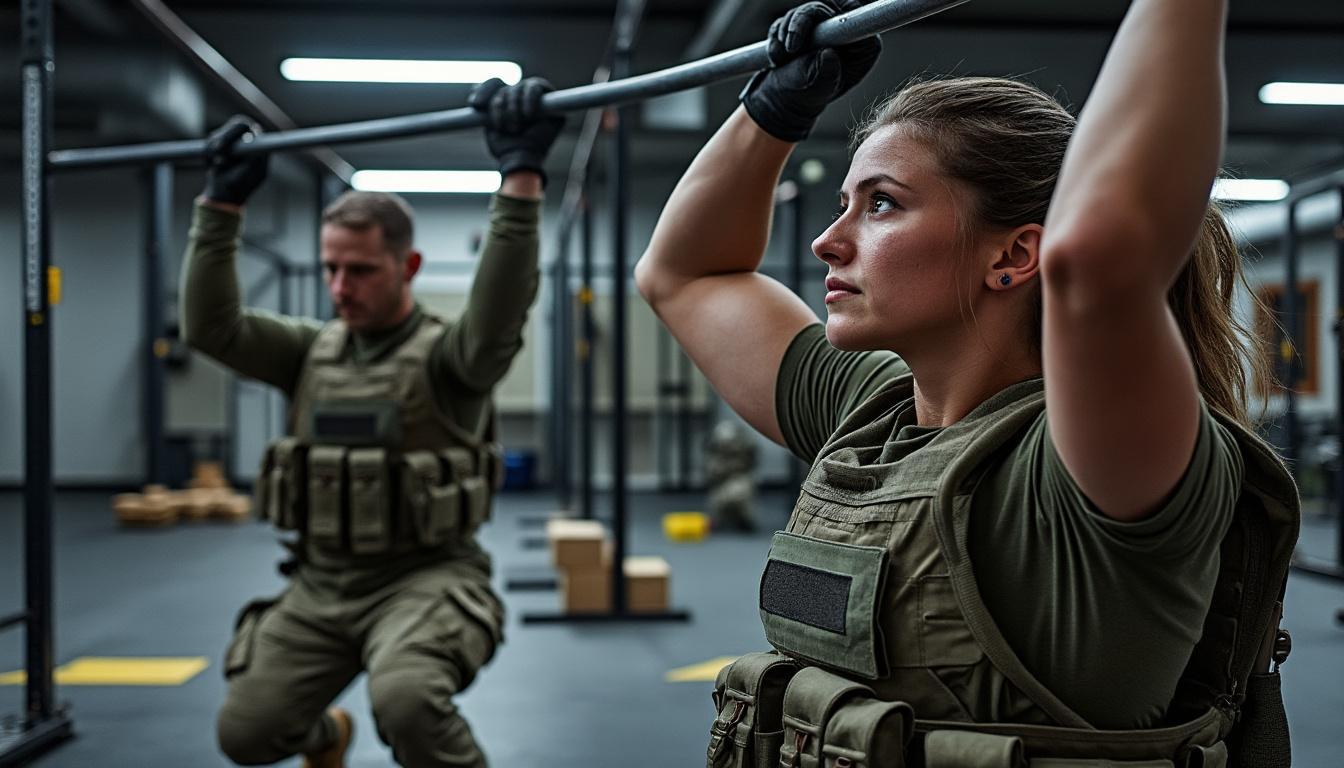The Air Force’s bold step towards an inclusive, age- and gender-neutral fitness assessment tailored for Explosive Ordnance Disposal (EOD) technicians marks a significant evolution in military fitness protocols. Designed to meet the stringent demands of this high-stakes career field, the new test aims to enhance operational readiness while embracing diversity in defense. Unlike previous standards that varied by gender and age, this progressive standard applies uniform criteria to all EOD airmen, promoting fairness and reflecting the realities of mission requirements. As this change unfolds, it offers valuable insights into the future of military physical assessments and training strategies, embodying an empowering shift for all who serve.
Revolutionizing Military Fitness: Introduction of Inclusive Age-Neutral Assessment for EOD Technicians
The United States Air Force has redefined military fitness testing by launching an age-neutral and gender-neutral physical assessment specifically for Explosive Ordnance Disposal (EOD) technicians—one of the most physically demanding roles within the armed services. Historically, EOD airmen were held to general Air Force fitness standards, which differentiated between men and women and were less demanding than their actual operational tasks warranted. This gap often translated to challenges in fully preparing airmen for the grueling physical efforts required in real-world scenarios.
With approximately 3% of the EOD field made up of women, the new assessment levels the playing field by setting unified standards that account for the occupational demands of EOD roles rather than demographic factors. This inclusive fitness approach acknowledges that operational performance—not age or gender—should dictate the physical criteria necessary to keep all airmen mission-ready and safe. This move mirrors broader military initiatives pushing for Diversity in Defense while simultaneously enhancing the combat capability of specialized units.
The new Physical Fitness Assessment (PFA) comprises four challenging events that are carefully chosen to simulate critical EOD tasks. These events include a 1,000-meter row to measure cardiovascular fitness, a 20-pound medicine ball toss evaluating functional upper-body strength, a trap bar lift assessing raw power with repetitions ranging from 150 to 360 pounds, and the intense Gruseter maneuver which involves donning a weighted vest, performing tactical rolls while carrying a 50-pound sandbag, and executing multiple sprints.
Notably, this assessment replaces the standard Air Force test for all enlisted members and officers within the EOD community, which speaks volumes about the tailored nature of the training regimen. Something that sets this initiative apart is its development over nearly a decade, starting in 2015. The Air Force consulted extensive performance data from both EOD and non-EOD airmen to ensure the test is operationally relevant and pragmatically challenging.
- Objective Data Utilization: The test is based on real-world task performance data, ensuring applicable strength and endurance requirements.
- Unified Standards: Equal passing scores regardless of sex or age, emphasizing fairness and operational necessity.
- Occupational Specificity: Each test element reflects skills essential to EOD duties including explosive device neutralization and casualty evacuation.
- Sustained Endurance: The test underscores endurance training as a critical component of EOD technician readiness.
- Implementation Timeline: Unofficial testing was conducted over the past year, transitioning to official records from August.
| Fitness Event | Primary Skill Evaluated | Operational Relevance |
|---|---|---|
| 1,000-meter Row | Cardiovascular Endurance | Sustained energy for prolonged missions and rapid response |
| 20-lb Medicine Ball Toss | Functional Upper-Body Strength | Simulates tasks such as climbing and casualty support |
| Trap Bar Lift (5 reps) | Explosive Power and Muscular Strength | Reflects lifting and carrying heavy equipment needed in field operations |
| Gruseter Maneuver | Agility, Strength, and Tactical Mobility | Combines carrying heavy loads, rolling, and sprinting under pressure |
Enhancing Operational Readiness through Gender-Neutral Training and Assessment Tools
Operational readiness in Explosive Ordnance Disposal units relies heavily on physical prowess rooted in strength, stamina, and strategic agility. The physical demands of EOD tech training are unparalleled, as airmen regularly engage in hazardous tasks including suspending hours in hot, cumbersome bomb suits and neutralizing improvised explosive devices (IEDs).
By introducing gender-neutral training standards, the Air Force ensures that all airmen meet the intrinsic physical requirements of their unique occupational environment. This change acknowledges that in combat or critical mission scenarios, performance metrics must prioritize capability over legacy categorizations like gender or age. The newly formed EOD Occupationally Specific Physical Fitness Assessment (OSPFA) centers around training and testing protocols that simulate real-life scenarios.
This approach produces several benefits for the force.
- Improved Mission Safety: Airmen physically prepared for the rigors of EOD missions experience fewer injuries and enhanced longevity in service.
- Standardized Performance Benchmarks: Equitable and consistent evaluations promote fairness and transparency in readiness assessments.
- Enhanced Morale and Confidence: EOD airmen who pass the rigorous test understand they possess verified operational strength.
- Broader Inclusion: Opening these roles to qualified candidates regardless of age or gender strengthens unit cohesion and capability diversity.
- Alignment with Defense Department Directives: Compliance with policies for sex-neutral physical standards issued in 2025 by Defense leadership.
| Benefit | Explanation | Long-Term Impact |
|---|---|---|
| Injury Prevention | Fitness tailored to job demands lowers risk of mission-related physical injuries | Improved force health and retention rates |
| Standardization | Uniform scoring regardless of demographic factors enforces fairness | Trust and professional respect within the ranks |
| Diversity and Inclusion | Broader representation encourages operational adaptability and innovation | Stronger, more cohesive fighting force |
| Morale Boost | Challenging yet equitable standards foster pride and motivation | Increased job satisfaction and retention |
| Policy Alignment | Conforms with DoD directives for combat-focused physical standards | Future-proofing military fitness strategies |
Incorporating these gender- and age-neutral standards into the military fitness routine ensures that every EOD airman is physically equipped to handle the mission’s harsh realities. This helps preserve lives and increases the effectiveness of Explosive Ordnance Disposal operations, critical for national security.
Milestones in EOD Tech Training: From Historic Fitness Tests to Current Specialized Standards
Evolution in physical fitness assessments for military personnel has been gradual but marked by critical turning points. EOD technicians endure one of the Air Force’s most demanding Tech Training pipelines, emphasizing preparation for extreme physical and mental challenges.
Prior to adopting the Inclusive Fitness Assessment, EOD technicians followed the standard Air Force Physical Fitness Test—a system that adjusted scoring expectations based on age and gender. That often led to discrepancies where airmen allowed to pass the general test found themselves unprepared for the rigors of real missions.
The transition towards gender-neutral standards began to accelerate after 2015, the year the Defense Department first opened all ground combat jobs to women. This shift laid the foundation for modern evaluations based on job-specific criteria instead of demographic generalizations.
- 2015: Women allowed to serve in ground combat roles; groundwork laid for inclusive assessments.
- 2015-2024: Ongoing development, data collection, and task analysis to tailor EOD-specific fitness tests.
- 2024: Unofficial administration of the new EOD test provides insights and adjustments.
- 2025: Official implementation of the age- and gender-neutral fitness assessment.
| Year | Event | Significance |
|---|---|---|
| 2015 | Opening combat roles to women | Marked shift in eligibility and fitness standards |
| 2015-2024 | Development of EOD-specific assessment | Extended data-driven approach tailored to job demands |
| 2024 | Unofficial testing phase | Experience-based refinement of test protocol |
| 2025 | Formal adoption of new standards | Enhanced operational readiness and inclusion |
These milestones reflect a larger military evolution toward focusing on practical capabilities to ensure every member is prepared for their mission. The Air Force’s approach offers a model for other units contemplating specialized, inclusive fitness assessments within their own ranks.
Operational Demands and Physical Conditioning: The Realities of Explosive Ordnance Disposal Roles
Explosive Ordnance Disposal technicians operate at the intersection of mental fortitude and supreme physical conditioning. Their duties often entail facing dangerous environments where precision and stamina can mean the difference between life and death. The bulky bomb disposal suits weigh roughly 50 pounds, while the physical tasks require sustained endurance as well as agility.
To simulate such conditions, the new assessment integrates tasks that echo the complexity of real operations. Components like the trap bar lift and the Gruseter maneuver directly challenge the muscle groups and energy systems vital for explosive handling, climbing, carrying loads, and quick tactical movements.
This reflects a significant upgrade from prior standards which were less indicative of real-world demands. By aligning training and testing directly with operational job functions, the Air Force strengthens both individual performance and unit cohesion.
- Functional Strength Development: Training focuses on transferable strength used in bomb suit operations and casualty evacuation.
- Cardio Endurance: Maintaining capability over extended hours in high-stress environments is crucial.
- Agility and Tactical Mobility: Rapid, precise movement is required for mission success.
- Load-Bearing Capacity: Handling heavy equipment repeatedly without injury preserves mission continuity.
- Mental and Physical Integration: Emphasizes conditioning under stress to mirror combat realities.
| Physical Demand | Conditioning Focus | Example from EOD Tasks |
|---|---|---|
| Maximal strength | Trap bar lifts and medicine ball tosses build lifting power | Moving explosive devices and equipment safely |
| Endurance | 1,000-meter row tests cardiovascular resilience | Long hours in bomb disposal suits during missions |
| Agility | Gruseter maneuver simulates quick tactical movement | Evasive actions and rapid relocation in the field |
| Load management | Carrying weighted sandbags and vests | Transporting heavy explosives or equipment across terrain |
| Coordination under fatigue | Multi-component exercises requiring complex motor skills | Performing bomb disposal tasks under physical strain |
This tailored conditioning blueprint is crucial for safety, effectiveness, and longevity in the EOD career path. The specialized fitness test also reflects broader trends in military fitness focused on specific occupational demands rather than generalized standards.
Future Directions: Inclusive Fitness Assessments Shaping Military Culture and Readiness
The Air Force’s initiative represents a cultural shift toward inclusive fitness that rejects stereotypes and outdated grading metrics. As other branches observe its success, it’s likely that inclusive, occupation-specific assessments will proliferate across multiple military specialties.
By enforcing identical physical standards for all EOD technicians, the Air Force creates a benchmark that values ability over demographics, thereby fostering a more diverse and capable force. This supports retention of elite talent and invites innovation within military fitness and training approaches.
Emerging technologies and data analytics will further refine these assessments, enabling real-time monitoring and personalized progression plans. This evolution supports longer career lifespans with injury prevention and recovery optimization — a vital consideration given the physical toll of military service.
- Expansion of Inclusive Testing: Anticipating broader adoption of age- and gender-neutral standards across other combat arms roles.
- Technology Integration: Wearable sensors and machine learning may optimize individualized training and assessment.
- Holistic Readiness Models: Combining physical, mental, and cognitive fitness into integrated evaluations.
- Enhanced Data Use: Leveraging large performance datasets to continuously update and validate standards.
- Promotion of Diversity and Equality: Breaking down barriers to entry while maintaining mission focus.
| Trend | Description | Impact on Military Fitness |
|---|---|---|
| Inclusive Assessment Expansion | Extending unified standards across multiple occupational specialties | Greater force efficiency and equality |
| Tech-Enabled Monitoring | Use of biometrics and AI in fitness programs | Personalized fitness and injury reduction |
| Holistic Fitness Approach | Integration of mental and physical health evaluations | Improved readiness and resilience |
| Data-Driven Standards | Real-time analysis guiding test updates | Adaptive and accurate benchmarks |
| Cultural Shift | Moving beyond gender and age biases | More diverse, motivated military personnel |
The embrace of inclusive fitness assessments significantly influences military culture, bringing focus to what truly matters: operational capability, resilience, and the wellbeing of all service members. For anyone interested in how specialized training molds elite forces, exploring related military fitness competitions or fitness assessment lifespan strategies reveals the deep connection between fitness standards and mission success.


